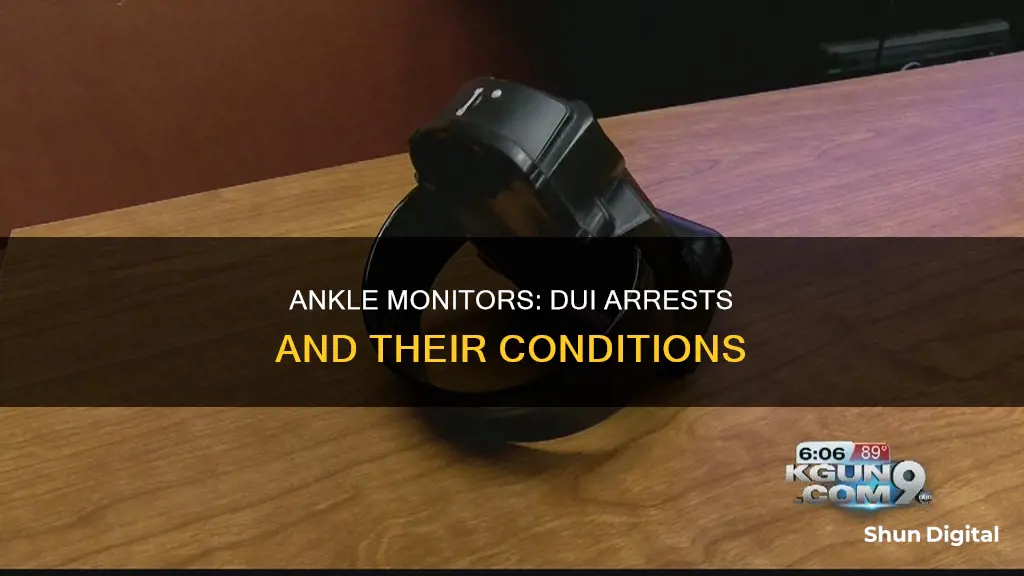
DUI arrests can lead to jail sentences, probation, community service, fines, or a combination of these penalties. Defendants are usually released on bail while awaiting trial, and judges often order them to abstain from alcohol during this period. To enforce this, judges may require defendants to wear an ankle monitor, or a Secure Continuous Remote Alcohol Monitor (SCRAM) device. These devices monitor the wearer's blood alcohol concentration by analysing their sweat every 30 minutes to two hours. They are often used for repeat offenders and can help them maintain employment and family commitments while ensuring they don't endanger the public by driving under the influence.
| Characteristics | Values |
|---|---|
| Name | Secure Continuous Remote Alcohol Monitor (SCRAM) |
| Purpose | Monitor blood alcohol concentration |
| Use | To enforce judges' orders that defendants be prohibited from consuming alcohol while on probation or awaiting trial |
| How it works | Analyses the wearer's sweat every 30 minutes to 2 hours |
| Appearance | Similar to ankle monitoring bracelets used for house arrest; two small boxes on either side of the leg, just above the ankle |
| Visibility | Small enough to be hard to notice when covered with pants |
| Installation fee | $50 to $100 |
| Daily monitoring fee | $10 to $15 |
| Monthly cost | Up to $450 |
| Installation location | Permanently affixed to the lower leg, above the ankle |
| Removal | Only allowed once the court-ordered sobriety period is over |
| Alert | If the wearer consumes alcohol, an alert is sent to a database and a trained analyst investigates further to determine if probation officers need to be notified |
| Tampering | If the wearer tampers with the device, an alert is sent to the service provider and the courts |
What You'll Learn
- SCRAM ankle monitors are used to enforce judges' orders that defendants be prohibited from consuming alcohol while on probation or awaiting trial
- SCRAM devices monitor the wearer's blood alcohol concentration by testing their perspiration every 30 minutes to 30 seconds
- SCRAM bracelets are monitored by a third-party company, which sends the data to a computer database that eventually ends up in the hands of the courts
- SCRAM bracelets are also used to monitor repeat DUI offenders out on bond
- DUI offenders are usually required to pay all costs associated with SCRAM devices, including installation and daily monitoring fees

SCRAM ankle monitors are used to enforce judges' orders that defendants be prohibited from consuming alcohol while on probation or awaiting trial
SCRAM (Secure Continuous Remote Alcohol Monitor) ankle monitors are used to enforce judges' orders that defendants be prohibited from consuming alcohol while on probation or awaiting trial. They are common in DUI cases, where a judge may require the defendant to avoid alcohol as a condition of their bail or pre-trial release. The monitors work by analysing the wearer's blood alcohol concentration (BAC) through their sweat every 30 minutes, and sending this data to a computer database which is eventually processed and sent to the courts.
The use of SCRAM ankle monitors is becoming more common as an alternative to incarceration for DUI offences, with judges able to enforce abstinence orders and monitor defendants 24 hours a day. The monitors are usually worn around the leg, just above the ankle, and are tamper-proof and water-resistant. They are designed to be worn 24/7, although wearers must avoid submerging the device in water.
In addition to the cost of the device itself, there is also a daily monitoring fee, which can quickly add up if a defendant is required to wear the monitor for an extended period. This financial burden can be particularly significant for those who are already facing hefty fines and other costs associated with a DUI charge. While SCRAM monitors can provide valuable insights into a person's alcohol consumption and help enforce court-ordered abstinence, they also raise concerns about the growing trend of "e-carceration" and the impact of criminal punishment on people's homes and intimate lives.
Removing G Chat Notifications from Your Right Monitor
You may want to see also

SCRAM devices monitor the wearer's blood alcohol concentration by testing their perspiration every 30 minutes to 30 seconds
SCRAM (Secure Continuous Remote Alcohol Monitoring) devices are electronic bracelets worn on the ankle to monitor a person's alcohol consumption. They are often used as an alternative to jail time for people charged with DUI/DWI or other alcohol-related offences.
When alcohol is consumed, it is metabolised by the body, with most of it processed and expelled by the kidneys. However, a small amount (about 1%) is secreted through the skin pores in the form of insensible perspiration. SCRAM devices test this perspiration for alcohol metabolites (the byproduct of alcohol after digestion) every 30 minutes. This is done through transdermal testing, where an electrochemical fuel cell within the SCRAM device measures the amount of ethanol gas within the perspiration.
The SCRAM device then sends the results to a monitoring agency, which notifies the appropriate court, police department, or supervising agency if alcohol is detected. While transdermal testing does not provide an immediate and exact blood alcohol concentration (BAC) measurement, it does offer a report of drinking "incidents".
In addition to monitoring alcohol consumption, SCRAM devices may also be equipped with GPS tracking capabilities, allowing authorities to monitor the wearer's whereabouts. This feature is particularly useful for house arrest or community control situations.
Built-in Monitor Speakers: Worth the Investment?
You may want to see also

SCRAM bracelets are monitored by a third-party company, which sends the data to a computer database that eventually ends up in the hands of the courts
SCRAM (Secure Continuous Remote Alcohol Monitor) bracelets are a common form of supervision for those arrested for DUI. They are often court-ordered for repeat offenders, deemed high-risk, or as a pretrial condition of probation. The bracelets monitor the wearer's blood alcohol concentration by testing their perspiration every 30 minutes to 30 seconds, 24 hours a day. This is known as transdermal alcohol concentration. The device then sends the data to a computer database monitored by a third-party company, which eventually ends up in the hands of the courts.
SCRAM Systems is the company that builds these devices and has a database that analyses alcohol consumption alerts. Once the offender consumes alcohol, an alert is sent to this database, and a trained analyst investigates further to determine if probation officers need to be notified. The analyst will review data from throughout the day to ensure it's consistent with actual drinking and will report any alcohol consumption or tampering with the device to the courts and the wearer's probation officer.
The cost of SCRAM bracelets includes an installation fee and a daily monitoring cost. The installation fee typically ranges from $50 to $100, while the daily monitoring fee can be around $10 to $15. This means the monthly cost of wearing a SCRAM bracelet can be as high as $450. Defendants are usually responsible for paying these costs, which can be a significant financial burden, especially when worn for extended periods.
While SCRAM bracelets do not monitor location, they provide accountability and help enforce the court's dictates regarding alcohol consumption. They offer an alternative to incarceration, allowing individuals to maintain employment and family commitments while ensuring they abstain from alcohol and remain law-abiding.
LCD Monitors: Polarized Filter Location and Functionality
You may want to see also

SCRAM bracelets are also used to monitor repeat DUI offenders out on bond
SCRAM (Secure Continuous Remote Alcohol Monitor) bracelets are commonly used to monitor repeat DUI offenders out on bond. They are often court-ordered as a condition of bail or probation, or as an alternative to jail time. Judges tend to reserve SCRAM sentences for repeat DUI offenders who present a threat to themselves and others on the road.
The SCRAM bracelet is an alcohol-monitoring device worn around the ankle 24 hours a day. It tests the wearer's perspiration for alcohol consumption every 30 minutes and sends the data to a monitoring company or agency. If alcohol is detected, the monitoring agency is notified, and they, in turn, notify the court and the police. The offender may then be subjected to a preliminary breath test to measure their BAC.
The SCRAM bracelet is a way to ensure that repeat DUI offenders who are out on bond remain sober and do not reoffend. It is also used to address other alcohol-related offenses such as domestic violence and assault. Offenders are typically responsible for the cost of the SCRAM bracelet, which includes installation and daily monitoring fees.
In addition to monitoring alcohol intake, SCRAM bracelets can also be outfitted with a radio frequency (RF) transmitter to monitor an individual's location, similar to a GPS monitor. This feature is often used for house arrest monitoring.
Best Places to Buy Desktop Monitors
You may want to see also

DUI offenders are usually required to pay all costs associated with SCRAM devices, including installation and daily monitoring fees
SCRAM (Secure Continuous Remote Alcohol Monitor) devices are often used to monitor DUI offenders and ensure they comply with alcohol restrictions. These devices are typically worn around the offender's ankle and test their blood alcohol concentration (BAC) through their sweat. While SCRAM devices are an effective tool for monitoring and enforcing accountability among DUI offenders, they do carry a financial cost.
DUI offenders are usually required to pay all costs associated with SCRAM devices, which can include installation fees and daily monitoring fees. The installation fees for SCRAM devices can range from $50 to $100, while the daily monitoring fees can be between $10 and $12. These costs can add up, especially if the offender is required to wear the device for an extended period.
In some cases, the court system may cover part of the cost for indigent DUI defendants who cannot afford the expense. Additionally, courts may impose financial assistance programs to help low-income individuals with the costs associated with SCRAM devices. However, it is important to note that the responsibility for paying the costs associated with SCRAM devices typically falls on the offender.
The financial burden of SCRAM devices can be significant, but it is important to consider the benefits and potential justifications for these costs. SCRAM devices provide continuous alcohol monitoring, allowing judges and authorities to take prompt action when violations occur. This not only enhances road safety but also improves the effectiveness of alcohol restriction enforcement. By reducing recidivism rates and preventing future DUI-related incidents, the costs of SCRAM devices may be justified.
Finding Your Raspberry Pi's IP Address Without a Monitor
You may want to see also
Frequently asked questions
SCRAM stands for Secure Continuous Remote Alcohol Monitor. It is an alcohol detector in the form of an ankle bracelet that DUI offenders are required to wear to monitor their blood alcohol concentration.
The monitor tests the wearer's sweat every 30 minutes to 30 seconds, 24 hours a day, for the presence of alcohol. This skin-level measurement is known as transdermal alcohol concentration.
Any attempts to tamper with, destroy, or remove the device will be reported to the court and the wearer's probation officer. This can result in harsher sentencing or prolonged probation.







